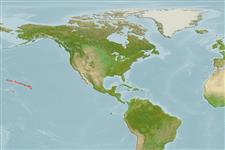>
Anguilliformes (Eels and morays) >
Ophichthidae (Snake eels) > Ophichthinae
Etymology: Myrichthys: Greek, myros, -ou = male of morey eel + Greek, ichthys = fish (Ref. 45335); magnificus: Name means splendid, an adjective..
Environment: milieu / climate zone / depth range / distribution range
Ökologie
seewasser demersal; tiefenbereich 1 - 262 m (Ref. 58302). Tropical
Eastern Central Pacific: Hawaiian Islands, Johnston Island, the Leeward Islands, and Midway Atoll.
Size / Gewicht / Alter
Maturity: Lm ? range ? - ? cm
Max length : 78.0 cm TL Männchen/unbestimmt; (Ref. 26145)
Kurzbeschreibung
Morphologie | Morphometrie
Wirbelzahl: 177 - 183. Body moderately elongate, depth 32-45 in TL; yellow to tan with brown to brownish-black spots, variable in size but about equal to or smaller than eye, the spots becoming more numerous in larger specimens. Pectoral fin length less than its base, about 2 in snout (Ref. 40867).
Common in shallow water and occasionally at the surface over sand and coral (Ref. 40867). Benthic in crevices and on sandy or rocky substrata (Ref. 58302).
Life cycle and mating behavior
Geschlechtsreife | Fortpflanzung | Ablaichen | Eier | Fecundity | Larven
Randall, J.E., 1996. Shore fishes of Hawai'i. Natural World Press, Vida, Oregon. 216 p. (Ref. 26145)
IUCN Rote Liste Status (Ref. 130435)
Bedrohung für Menschen
Harmless
Nutzung durch Menschen
Mehr Information
NamenSynonymeMetabolismusRäuberÖkotoxikologieFortpflanzungGeschlechtsreifeAblaichenSpawning aggregationFecundityEierEientwicklung
Alter/GrößeWachstumLänge-GewichtLänge-LängeLängenhäufigkeitenMorphometrieMorphologieLarvenLarven Pop.Dyn.RekrutierungDichteBRUVS
ReferenzenAquakulturAquakultur ProfilZuchtlinienGenetikElectrophoresesVererbbarkeitKrankheitenVerarbeitungNutrientsMass conversion
PartnerBilderStamps, Coins Misc.LauteCiguateraGeschwindigkeitSchwimmstilKiemenoberflächeOtolithsGehirngrößeSehfähigkeit
Tools
Zusatzinformationen
Download XML
Internet Quellen
Estimates based on models
Preferred temperature (Ref.
123201): 5.5 - 15.2, mean 8.7 °C (based on 7 cells).
Phylogenetic diversity index (Ref.
82804): PD
50 = 0.5005 [Uniqueness, from 0.5 = low to 2.0 = high].
Bayesian length-weight: a=0.00089 (0.00039 - 0.00204), b=3.00 (2.80 - 3.20), in cm total length, based on LWR estimates for this (Sub)family-body shape (Ref.
93245).
Trophic level (Ref.
69278): 3.5 ±0.4 se; based on size and trophs of closest relatives
Widerstandsfähigkeit (Ref.
120179): mittel, Verdopplung der Population dauert 1,4 - 4,4 Jahre. (Preliminary K or Fecundity.).
Fishing Vulnerability (Ref.
59153): Moderate to high vulnerability (51 of 100).
